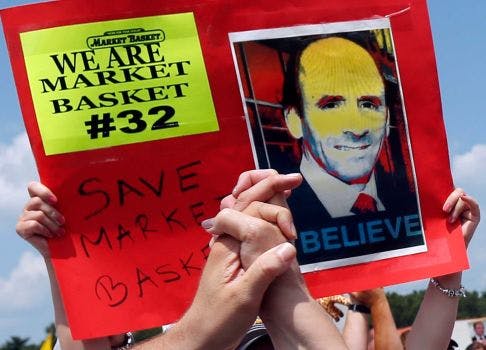A billion dollar family business has been rocked by the voting out of the “enemy” relative who all employees love.
That’s the story of Market Basket, the Tewksbury, Massachusetts-based grocery chain of 71 stores with some 25,000 employees throughout the Northeast.
A groundswell of popular support — rallies, strikes, and protests attended by thousands of loyalty workers — has followed the firing of Arthur T. Demoulas, its former beloved CEO. Demoulas was replaced in June by a board now controlled by his cousin, Arthur S. Demoulas, a rival heir to the company built by their Greek immigrant grandparents, who opened their first store in 1916.
Although the stores remain open, shelves are sparse because warehouse drivers as well as outside vendors have refused to make deliveries. Customers have taken to social media to show their support for the employees trying to get their boss back. The company is losing millions of dollars a day.
The Market Basket phenomena has rocked corporate America to the core and left many shocked and bewildered. How can employee loyalty backfire?
There are many critical takeaways from what is happening with Market Basket. Leadership should take notice and make sure that these lessons are reviewed and discussed in their next team meetings:
1. Keep your ear to the ground
Call it a “win for the Gipper” or their “Norma Rae moment” — people have a tendency to stand up for the underdog. And the crowd influence of social media can magnify that fight for injustice like nothing else.
Companies need to understand just how quickly discontent can become a rallying cry that can impact performance and potentially damage the brand. Listen to your team and address concerns early on. Clear and tangible strategies that drive employee satisfaction and engagement are critical, as is honest communication and nimble response.
Feeling valued and respected is one of the key requirements for a truly engaged employee. Cultivating employee loyalty starts at the individual level but is also critical in optimizing the group dynamic of your workforce.
2. Customer loyalty is directly tied to employee loyalty
Most successful consumer based organizations allocate significant budget to support customer loyalty and engagement programs.
Many, however, don’t appropriate a significant amount of resources to driving employee loyalty and engagement. Organizational cultures that don’t focus on motivating, training, engaging and rewarding their employees have little chance of achieving the optimal customer experience.
All of the customer loyalty initiatives in the world can’t overcome a disgruntled, disengaged workforce. The coupons, price breaks, and corporate pleas didn’t stop the Market Basket customers from pushing their carts into the likes of the competitor Stop & Shop, much less lining up behind the boycotting employees.
How you treat your employees directly affects how your employees treat your customers.
3. Get back to basics, where everybody knows your name
We spend an inordinate amount of our lives at work and our environment matters. Employee satisfaction and loyalty isn’t only driven by robust reward and recognition programs, but instead, is more basic and must less expensive.
We saw this first hand with the Market Basket situation. Employees were loyal to a CEO who knew their names, asked about sick family members, sent notes of graduations and weddings, and gave a pat on the back and praise for a job well done.
Not to dilute the value of equitable wages and well-developed recognition programs, but the leadership was the driving force for these employees. They were willing to risk their livelihood for a leader who took the time to develop a personal relationship.
Successful customer and employee loyalty programs today MUST include personalization; it is a fundamental element.
A powerful connection
We all want to feel special, that we are worth taking to time to get to know so that we can make a difference. What we see with Market Basket is just how powerful this connection can be – both for employees as well as customers. It makes all of the difference in the world.
C-Suite executives everywhere should be convening emergency meetings to inventory their employee and customer loyalty strategies. And if you are void of strategies, or have words on paper that haven’t translated to the fabric of your culture, you should consider re-prioritizing efforts to avoid being the next Market Basket.
